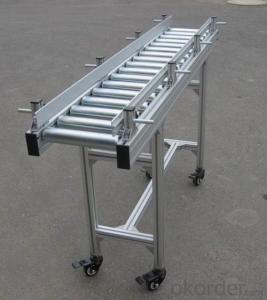Aluminum Window Profile Customerized Design
- Loading Port:
- Shanghai
- Payment Terms:
- TT OR LC
- Min Order Qty:
- 0.22
- Supply Capability:
- 10000 m.t/month
OKorder Service Pledge
OKorder Financial Service
You Might Also Like
Aluminum Frame and Corner
Products Introduction of Aluminum Frame and Corner
Aluminum frame is made from aluminum and minerals. It's raw matrial for window frame, window frame, and other equipment frame. It's easy for construction, cost less, service longer than other materails. The size and design can be customerized.
Advantage of Aluminum Frame and Corner
-Build FLEXIBLE equipment, window, door.
-Bolt your structure together
-Build with Aluminum MORE EASILY
-Aluminum costs LESS
-Service life is more than 10 years
-Can be customerized
Specifications
(1) Product: Aluminium Frame;
(2) Material: Alloy 6063/6061/6005/6060, T5/T6;
(3) Finish: anodizing, powder coating, wooden, electrophoresis or any color;
(4) Size: customized, same as drawings or samples;
(5) Standard: High-quality;
(6) Characteristics: strong, stylish, durable, corrosion-resistant.
Aluminium Alloy: 6063, 6061, 6005, 6060 Thermal Treatment: T5, T6
Section Shapes
I, U, T, C, Z, L, H, square, round, flat, hollow, t-slot, and other complicated shapes by custom design.
Surface treating
Mill / Anodizing (oxidation) / Sand blasting / Powder Coating / Electrophoresis / PVDFCoating / Wood effect.
Application
1) - for Window and door frames, for Wardrobe cabinet sliding doors, kitchen, for Building curtain glass walls
2) -for Fencing, Rail, Deck and Frame.
3) - for Solar panel frames, solar mounting / roofing brackets
4) - for Industry assembly lines equipment.
5) - for Heatsinks, for LED lighting.
7) - other by custom design size and dimension
FAQ
-What's your company profile?
We CNBM is the largest building material supplier of China. We are Chinese government owned corporation, which takes the 267th place in WOLD FORTUNE 500 CORPORATION. We own the largest prodcution base in North and South of China. With more than 15 warehouses and offices in different countries, our products sell very well all over the world. We have whole quality control system. We'll be your reliable partner.
-Which kind of payment do you usually support?
TT, LC at sight.
-Can you provide samples?
Yes, we provide free of charge samples, you just need to pay for the delivery.
Photos:
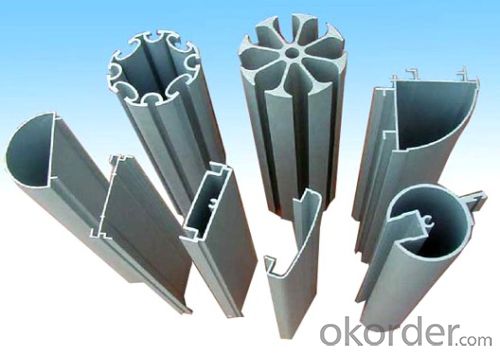

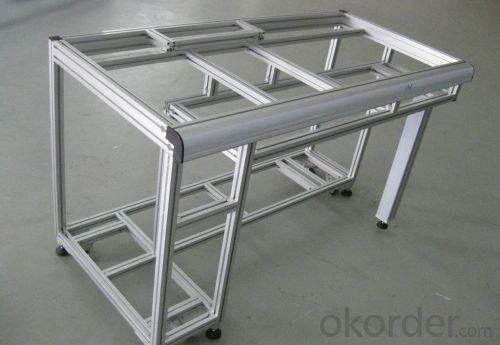

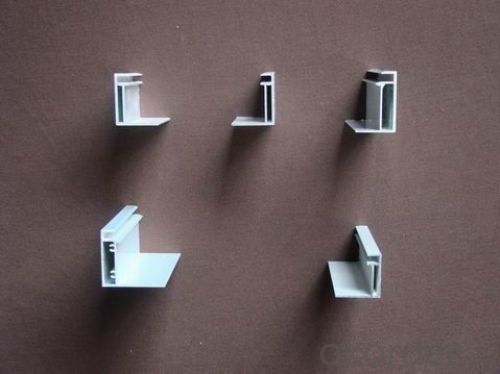
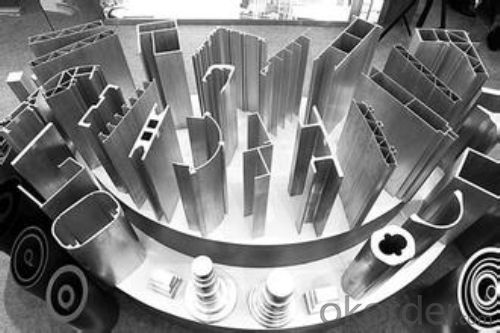
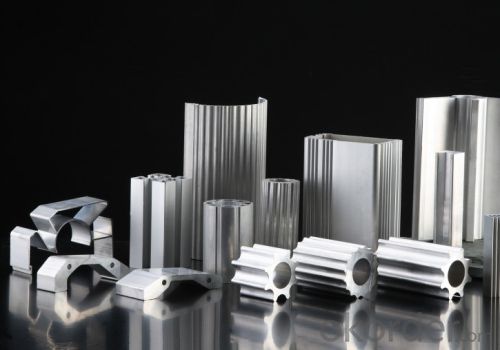
- Q:What is the composition of aluminum profiles?
- Aluminum profiles are primarily composed of aluminum, which is a lightweight and highly malleable metal. They may also contain small amounts of other elements such as copper, magnesium, silicon, and zinc, depending on the specific alloy used. These additional elements are added to enhance the strength, durability, and other desired properties of the aluminum profiles.
- Q:Can aluminum profiles be used for automotive roof racks or cargo systems?
- Automotive roof racks or cargo systems can indeed utilize aluminum profiles. Aluminum, a material known for its durability and lightweight properties, is widely employed in the automotive sector owing to its impressive strength-to-weight ratio. Its resistance to corrosion is especially crucial for roof racks as they are exposed to the elements. Moreover, aluminum profiles can be effortlessly molded and tailored to meet specific specifications, rendering them appropriate for diverse cargo system designs. In summary, owing to their strength, lightweight nature, and resistance to corrosion, aluminum profiles are highly favored for automotive roof racks and cargo systems.
- Q:What is the nitriding process of aluminum extrusion die?
- The principle of nitridation:Gas nitrocarburizing, that is gas nitrocarburizing, refers to low temperature nitrocarburizing based on gas nitriding and carburizing. Commonly used media have 50% ammonia, +50% endothermic gas (Nitemper method); 35%-50% ammonia, +50-60% exothermic gas (Nitroc method) and ammonia through the drip ethanol or formamide and so on. In soft nitriding, because of the high solubility of carbon atoms in the epsilon phase, the soft nitrided surface is a common compound of carbon and nitrogen, which is good in toughness and wear resistant.In the process of gas nitrocarburizing, due to the extremely low solubility of carbon atoms, it quickly reaches saturation state and precipitates many super micro cementite points. These cementite particles, as the core of the crystallization of nitrides, contribute to the formation of nitrides. When the surface nitrogen concentration reaches a certain level, the epsilon phase is formed, while the carbon solubility of the epsilon phase is very high, which in turn accelerates the dissolution of carbon.After gas nitrocarburizing, its structure is composed of epsilon phase, gamma phase and nitrogen containing cementite Fe3 (C, N), carbon will reduce the diffusion rate of nitrogen, so the thermal stress and the stress of the tissue are hard, the nitriding is large and the layer is thinner. But at the same time, because the soft nitride layer does not exist. Therefore, the nitride layer, better toughness than hard nitriding
- Q:What are the different types of anodizing options for aluminum profiles?
- There are several different types of anodizing options available for aluminum profiles, each with its own unique benefits and characteristics. Some of the most common types of anodizing include: 1. Type I - Chromic Acid Anodizing: This is a thin and non-decorative anodizing process that provides excellent corrosion resistance. It is often used as a primer for paints or adhesives. 2. Type II - Sulfuric Acid Anodizing: This is the most commonly used anodizing process, which produces a thicker and more durable oxide layer. It can be further classified into two subtypes: regular sulfuric anodizing and hardcoat anodizing. Regular sulfuric anodizing provides good corrosion resistance and can be dyed in various colors for aesthetic purposes. Hardcoat anodizing, on the other hand, produces a very hard and wear-resistant surface, making it suitable for applications with high abrasion or wear. 3. Type III - Sulfuric Acid Hardcoat Anodizing: Also known as hard anodizing, it is a specialized process that produces an even thicker and denser oxide layer than regular sulfuric anodizing. This results in enhanced wear and corrosion resistance, making it ideal for applications in harsh environments. 4. Type IV - Boric-Sulfuric Acid Anodizing: This is a relatively new anodizing process that combines sulfuric acid anodizing with a boric acid bath. It produces a thin and hard oxide layer with improved wear resistance and reduced electrical conductivity. 5. Type V - Phosphoric Acid Anodizing: This type of anodizing is typically used for specific applications where a thin, dense, and hard oxide layer is required. It offers good corrosion resistance and can be dyed for aesthetic purposes. These different types of anodizing options for aluminum profiles allow for a range of properties and appearances, making them suitable for various applications such as architectural, automotive, aerospace, electronics, and more. The choice of the anodizing type depends on the specific requirements and desired outcome of the aluminum profile.
- Q:Are aluminum profiles compatible with glass?
- Yes, aluminum profiles are compatible with glass. Aluminum frames are commonly used in the construction industry to hold and support glass panels in windows, doors, and other architectural applications. The lightweight, durable, and corrosion-resistant properties of aluminum make it an ideal material for framing glass.
- Q:Can aluminum profiles be used in the construction of stadium seating systems?
- Yes, aluminum profiles can be used in the construction of stadium seating systems. Aluminum is lightweight, durable, and easily customizable, making it an ideal material for creating the framework of stadium seating systems. It offers structural stability and can withstand heavy loads, ensuring the safety and comfort of spectators. Additionally, aluminum profiles can be easily assembled and disassembled, allowing for flexibility and easy maintenance of the seating system.
- Q:Are aluminum profiles suitable for conveyor systems?
- Yes, aluminum profiles are suitable for conveyor systems. Aluminum is a lightweight and durable material that is commonly used in various industries for its numerous advantages. Firstly, aluminum profiles offer excellent strength-to-weight ratio, making them ideal for conveyor systems. They can support heavy loads while still being lightweight, allowing for easy installation and flexibility in design. This characteristic is particularly advantageous in conveyor systems where efficiency and ease of movement are crucial. Secondly, aluminum profiles are corrosion resistant. Unlike other metals, aluminum does not rust, ensuring the longevity and reliability of the conveyor system. This is especially important in industries that deal with moisture or harsh environments. Moreover, aluminum profiles are highly customizable. They can be easily machined and shaped to meet specific requirements and dimensions of the conveyor system. This allows for the creation of unique and efficient designs, ensuring optimal performance and functionality. Additionally, aluminum profiles have excellent thermal conductivity. They quickly dissipate heat, preventing any potential damage or overheating of the conveyor system. This is particularly beneficial in industries that involve high-temperature processes. Furthermore, aluminum profiles are cost-effective. While the initial investment may be slightly higher compared to other materials, the long-term benefits outweigh the costs. Aluminum requires minimal maintenance, reducing downtime and associated expenses. In conclusion, aluminum profiles are indeed suitable for conveyor systems. Their lightweight nature, corrosion resistance, customization options, thermal conductivity, and cost-effectiveness make them an ideal choice for a wide range of conveyor applications.
- Q:Can aluminum profiles be used in the manufacturing of furniture?
- Yes, aluminum profiles can be used in the manufacturing of furniture. Aluminium profiles are lightweight, durable, and versatile, making them suitable for various furniture applications. They can be used to create frames, legs, handles, and other structural components in furniture designs. Additionally, aluminum profiles offer a modern and sleek aesthetic, making them popular in contemporary furniture styles.
- Q:What does "3030W" W mean for European standard industrial aluminum?
- This refers to the 3030 heavy aluminum profiles. General aluminum profile manufacturers will make a number of their own products, European standard 3030 series has a variety of specifications, such as Jing Teng aluminum European standard 3030R, referring to the European standard 3030 fan, 3030G refers to the 3030 GB profiles. In short, look at your own needs,
- Q:What kinds of profiles are made of aluminium alloy windows?
- Very simple outline of the material: square tube (Fang Tiao), winger, on the slide, down the inner frame of the material: hook enterprises, light enterprises, the upper cross, lower cross
1. Manufacturer Overview |
|
|---|---|
| Location | |
| Year Established | |
| Annual Output Value | |
| Main Markets | |
| Company Certifications | |
2. Manufacturer Certificates |
|
|---|---|
| a) Certification Name | |
| Range | |
| Reference | |
| Validity Period | |
3. Manufacturer Capability |
|
|---|---|
| a)Trade Capacity | |
| Nearest Port | |
| Export Percentage | |
| No.of Employees in Trade Department | |
| Language Spoken: | |
| b)Factory Information | |
| Factory Size: | |
| No. of Production Lines | |
| Contract Manufacturing | |
| Product Price Range | |
Send your message to us
Aluminum Window Profile Customerized Design
- Loading Port:
- Shanghai
- Payment Terms:
- TT OR LC
- Min Order Qty:
- 0.22
- Supply Capability:
- 10000 m.t/month
OKorder Service Pledge
OKorder Financial Service
Similar products
New products
Hot products
Related keywords


